Every day, we navigate a sea of information, acquire new insights, and make a myriad of minor and significant decisions. As Product Managers, we bear the crucial responsibility of making key decisions that shape the future success of our product. Effective decision-making demands an in-depth understanding of our users, market, and product, augmented by a well-curated arsenal of mental models.
What is a mental model? A mental model is a pattern, representation, or explanation of how something works. Our brains create patterns or models to understand complex information. We cannot keep all the details of the world in our brains, so we use models to simplify the complex into understandable and organized chunks. We use these models daily to think, make decisions, understand new concepts, and find solutions to problems. Each of us has hundreds, if not thousands, of mental models. While there are probably millions of mental models out there, not all of them are true or useful, and you don’t have to know all of them. You should know the important ones. Let’s review some of the most useful mental models for product managers.
The Pareto Principle
The Pareto Principle, or the 80/20 rule, is a concept that states that 80% of the effects come from 20% of the causes. This principle can be applied to a variety of fields, including economics, engineering, and management. In product management, the principle can be applied in a number of ways. For example, it can be used to prioritize features for development. By identifying the top 20% of features that provide 80% of the value, product managers can ensure that their development efforts are focused on the most important features. Additionally, the principle can be used to identify areas for improvement in existing products. By analyzing which features provide the most value, product managers can identify areas where improvements can be made to increase the product’s overall value. Similarly, in the field of engineering, the principle can be used to identify the causes of defects in products. By focusing on the top 20% of the causes, engineers can eliminate 80% of the defects.
First Principles Thinking
There are many different methods and tools to get to the solutions, but the principles are few. First principles thinking is a mental model that involves breaking down a problem into its fundamental principles and then building up from there. This approach is often used by Elon Musk, who famously said,
“You have to start with the fundamental truth and reason up from there.”
People who understand the fundamental principles can use any method or come up with their own methods. However, people who blindly use methods without understanding the underlying principles are bound to make mistakes. By applying first principles thinking to product development, you can challenge assumptions and come up with innovative solutions. The 5 Whys is a problem-solving technique that involves asking “why” five times to get to the root cause of a problem. By using this technique, you can identify the underlying causes of a problem and address them directly, rather than just treating the symptoms.
Second Order Thinking
All of us can anticipate the immediate results of our actions. This is first-order thinking. Second-order thinking involves considering the subsequent effects of those actions, i.e. thinking further ahead - when making choices, considering consequences can help us avoid future problems. We must ask ourselves the critical question: “And then what?” Asking this question would help you to consider the potential long-term consequences of your choices and make more informed and strategic decisions.
Second-order thinking is a valuable tool to use when making decisions, prioritizing long-term interests over immediate gains and constructing effective arguments.
Occam’s Razor
“Occam’s Razor” is a mental model that suggests that, when presented with multiple explanations for a phenomenon, the simplest explanation is often the best one. The principle is also known as the “law of parsimony” and is commonly attributed to the medieval philosopher and theologian William of Ockham.
For example, if you are trying to determine why a product feature is not performing as expected, you may consider a range of explanations, such as poor user experience design, inadequate marketing, or technical issues. By applying Occam’s Razor, you would favour the explanation that requires the fewest assumptions or variables, all other things being equal. In this case, you may determine that poor user experience design is the simplest explanation, and therefore the most likely one.
Overall, Occam’s Razor is a useful mental model for product managers to use when evaluating options and making decisions. It encourages simplicity and clarity and can help you to prioritize and focus on the most important factors influencing a problem or decision.
The Curse of Knowledge
The Curse of Knowledge is a cognitive bias that occurs when people who are knowledgeable about a topic have difficulty explaining it to someone who is not knowledgeable. This can lead to poor communication and misunderstandings. Product managers can use this mental model to avoid jargon and technical terms when communicating with customers or other stakeholders. By using clear and simple language, you can ensure that everyone understands the message you are trying to convey.
The Map is not the territory
Anything that is trying to model something else can’t be accurate because it’s not an actual thing. In product management, this mental model can be used to help teams recognize that different stakeholders may have different perspectives on the same issue or problem. By understanding that each person’s mental map of the situation is unique, product managers can work to find common ground and collaborate more effectively.
Conclusion
I covered just some of the most known mental models, and as you can see, mental models are useful tools that can improve your thinking, help you learn new concepts faster and help you make better decisions in your daily life. Check out fs.blog and Untools to learn more.





Comments